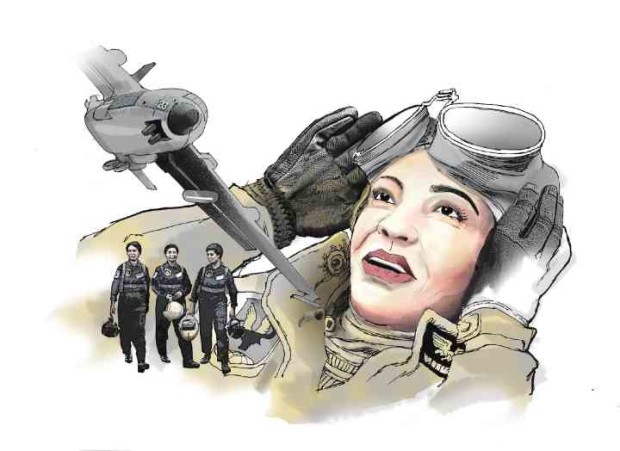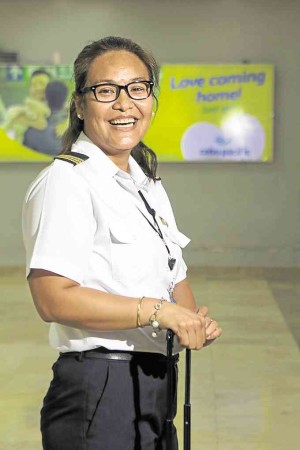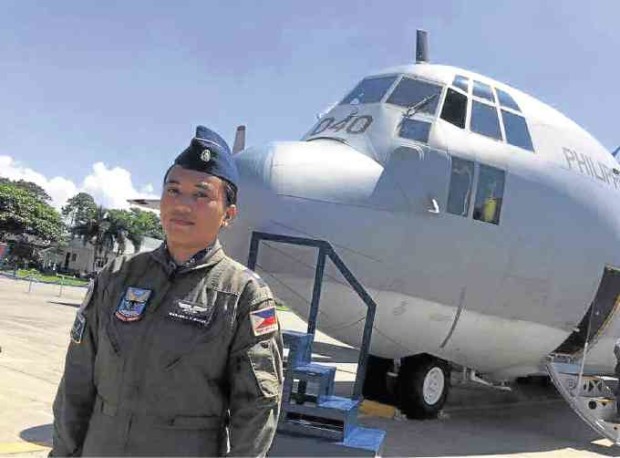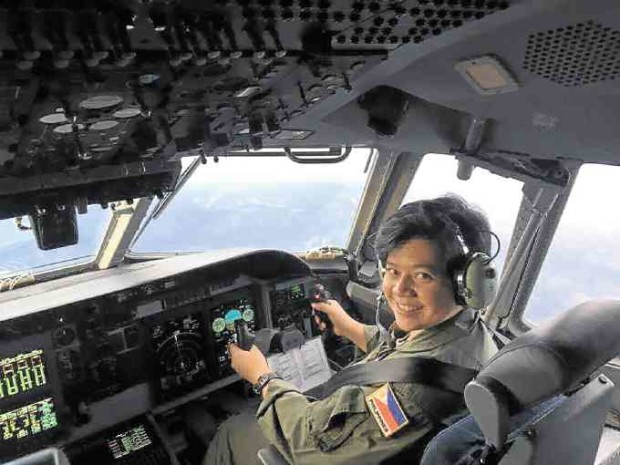Reaching for the skies
Women have redefined gender roles in the workplace, and the Philippine Air Force (PAF), the air unit of the Armed Forces of the Philippines, is no exception.
The sight of women working in the military — where physical prowess and aggression are expected — is both a breakthrough and a continuing challenge for women who find themselves in male-dominated and male-identified jobs.
From a pioneer batch of four female combat pilots in December 1997, the number has now reached 200 female military pilots who are flying planes for combat, rescue and transport.
Lt. Col. Lilian Busto, 44, was only 25 when she enlisted to be among the first female combat pilots. She was with the 15th Strike Wing, which actively gives air support to the ground troops in Mindanao. She flew the MG-520 attack helicopter.
“We were received and taken in as pilots and not as women. What makes it different is that Filipino gentlemen are gentlemen. Sometimes they make the adjustments for us,” said Busto, who was also the first Mindanaoan combat pilot.
The PAF first announced the assignment of women pilots on combat duty in March 1999, in line with the government’s policy of giving equal opportunity to women in the Armed Forces.
Busto recalled the birth pains of the new policy when their unit was deployed in Cotabato, Davao, Zamboanga and Jolo in Mindanao.
“Our unit back then were not that ready for females yet. In some instances, we did not have our own comfort rooms, and the sleeping areas were in a big room with plywood partitions,” she recalled.
But “we adjusted because we did not want to call attention to ourselves and ask for special treatment because of our gender. These days, however, everything is pretty much in order.”
A communication arts graduate of Ateneo de Davao University, Busto was an Inquirer news correspondent covering Davao City for over a year before she entered the Philippine Air Force Flying School (PAFFS) in 1995 after much prodding from her aunt who had several friends in the PAF.
Not letting the opportunity pass, she took the written exam and noticed that she was the only woman in the group. She later emerged as the only Davao City resident who passed the exam.
“Simply put, not everyone gets to become a pilot and a military pilot at that,” Busto said.
In an opinion piece she wrote for the Inquirer in 2002, she recalled how her colleague Mary Grace Baloyo died after the OV-10A plane she had piloted crashed in Pampanga. It was a tragic end for Baloyo, Busto’s classmate in flying school and a pioneer woman combat pilot.
Busto knew from the start how the job comes with risks to life and limb. But she was young, single and ready to take on anything, until her priorities changed. She ceased flying the unfriendly skies in 2001. Today, she is happily married to a former military pilot with whom she has a 14-year-old son.
But Busto still gets to fly as a transport pilot with the 220th Airlift Wing that carries troops, equipment and goods, while serving as division chief for plans and program at the office of the deputy chief of staff for personnel.
Her direct upper class officer back in the PAFFS, FO1 Rowena Ayudan, 44, also recalled the challenges women faced in their early days in the Air Force.
“Some men were nice but others viewed us with a sneer. You have to prove yourself with hard work,” said Ayudan, who belonged to the 1996 batch.
Also an “accidental pilot,” Ayudan planned to teach and become a lawyer after graduating with a literature degree from Saint Louis College (now Saint Louis University)in Tuguegarao City, Cagayan. But she took the PAF qualifying exam with her friends, passed it, and had never looked back.
Ayudan left the service in 2009 and has since been flying an Airbus 319 and 320 for an airline company.
But her military experience shaped the pilot that she is today. She was the first female to fly a Lockheed C-130 Hercules plane in the PAF as a copilot.
The C-130 is a cargo plane used especially during disasters and evacuation. It is also the fastest means to ferry goods and people.
In one of the C-130 flights from Manila that Ayudan piloted with full passenger capacity, two of the plane’s four engines encountered problems.
“We shut down two engines and we had to return to Manila with a very heavy load. We landed successfully, with burst tires. But everyone was alive and there was only minor damage to the aircraft,” she recalled.
In the United States, Monessa Catuncan has been soaring into the skies as the first Filipino-American woman to pilot an F-16 fighter aircraft.
She was the class valedictorian of Mesquite High School in Texas and graduated with an aeronautical engineering degree from the US Air Force in Colorado, according to the Asian Journal.
Another trailblazer is transport pilot Maj. Marjorie Mukay, 35. In November 2015, the PAF watched Maj. Mukay become the first female pilot in command of the C-130 plane. The flight flew from Manila to Zamboanga to Cebu, after which Mukay’s instructor certified her a “full-fledged pilot in command,” a milestone she likens to “getting a diploma.”
“Being qualified to become a pilot in command of the C-130 and being [the first] female [to do so] are big achievements for me. I never imagined that I would be flying that plane in the first place because I originally planned to fly a helicopter,” Mukay told the Inquirer.
Mukay said that making history as the first female pilot in command of C-130 “just happened.” She was not the first woman to attempt to fly the cargo plane.
“Others just did not pursue it maybe because it is physically demanding. I have to wake up early to leave for a flight, arrive around midnight after a long flight, and do the same routine again the next day,” she said.
Mukay summed it up, “I am not an extraordinary pilot and I do not have superb flying skills. (Yet) I wanted it, so I just pursued it.”
But more than her personal triumphs, Mukay sees her work in the Air Force as something bigger than herself. For someone who once dreamed of becoming a doctor, she found another way to save lives.
As a transport pilot, Mukay said, she met a hundred or so evacuees whom she needed to bring back to their families safely. She also met hungry victims of disasters who patiently waited for the food and water that she carried.
This makes the responsibility and accountability much bigger because other lives are at stake, Mukay said.
Currently designated as a standard and evaluation officer of the Air Force safety office, she is tasked with the evaluation of pilots and other air crew, on top of other safety duties in flight and on the ground.
Mukay was a third year Pharmacy student when she decided to enter the Philippine Military Academy. She was among the top 10 of the “Sanlingan” Class of 2005.
“As a young lieutenant, I was with an all-male group. [Unfortunately], some senior male officers still see female officers as good only for administration work,” she said.
Facilities dedicated for women were not yet established, she recalled.
But for Mukay, aviation is more about skills and less about gender. “Piloting is a skill anyone can learn,” she said.
“I feel rewarded as a C-130 pilot every time ordinary people, especially those who cannot afford an airline ticket, are able to avail themselves of the free services of the PAF.
“Every time I land in an airport, even a smile, an expression of their gratitude, makes me feel rewarded and accomplished. And that’s enough for me,” Mukay said. “These are the instances when I feel I have served the Filipino people best.”


















